Last Updated on January 29, 2022 by Heather Hart, ACSM EP, CSCS
For runners, the task of figuring out how to fuel for a race can be daunting. There are seemingly endless nutrition options, and everyone’s body reacts differently to each one. It takes practice, trial, and error to find out what works for each individual.
But if race day nutrition is an art form, fueling for an ultramarathon distance race can feel like rocket science.
As any experienced ultrarunner can tell you: if you don’t properly fuel during your race, you’re going to have a bad, bad day (the stories I could share about my own race day nutrition fails could be an entire post of their own). “Bonking” is just the start: tears, gastrointestinal distress, cramps, confusion, and more can stem from under-fueling during an ultra.
Point being: having a proper fueling strategy for an ultramarathon is absolutely vital for race day success, and there’s no doubt that the significantly longer distances and extended time on feet require much more involved nutrition strategies. In this post, we’ll dive deeper into exactly how to formulate, practice, and come race day, execute, your own ultramarathon race day nutrition plan.
Determining Your Individual Ultramarathon Nutrition Needs
If you’ve heard it once, you’ve heard it a thousand times: “don’t try or do anything new on race day.” There’s a very valid reason for this mantra in the running world, new things may cause discomfort. We’re talking anything from a blister to an extended visit behind a bush because you pissed off your gastrointestinal system.
When it comes to nutrition, you have to practice ultramarathon fueling plan time and time again to make sure it truly works for you. Here’s how to start:
Determine Your Caloric Expenditure
It’s commonly stated that running burns approximately 100 calories per mile. It’s important to note the “approximate” clause in that statement. In reality, caloric expenditure is going to vary based on a number of individual factors, including, but not limited to: gender, weight, athletic conditioning, effort, climate you are running in, etc.
Of course, in order to get a near exact (or at least better than a guess) estimate of your personal caloric expenditure, you likely need to visit an exercise science lab. However, since that’s not an available option for most ultrarunners, your next best bet is to do some calculations. Or better yet, have an online calculator – like this Walk/ Run Metabolic Calculator from ExRx.net – do the calculations for you.
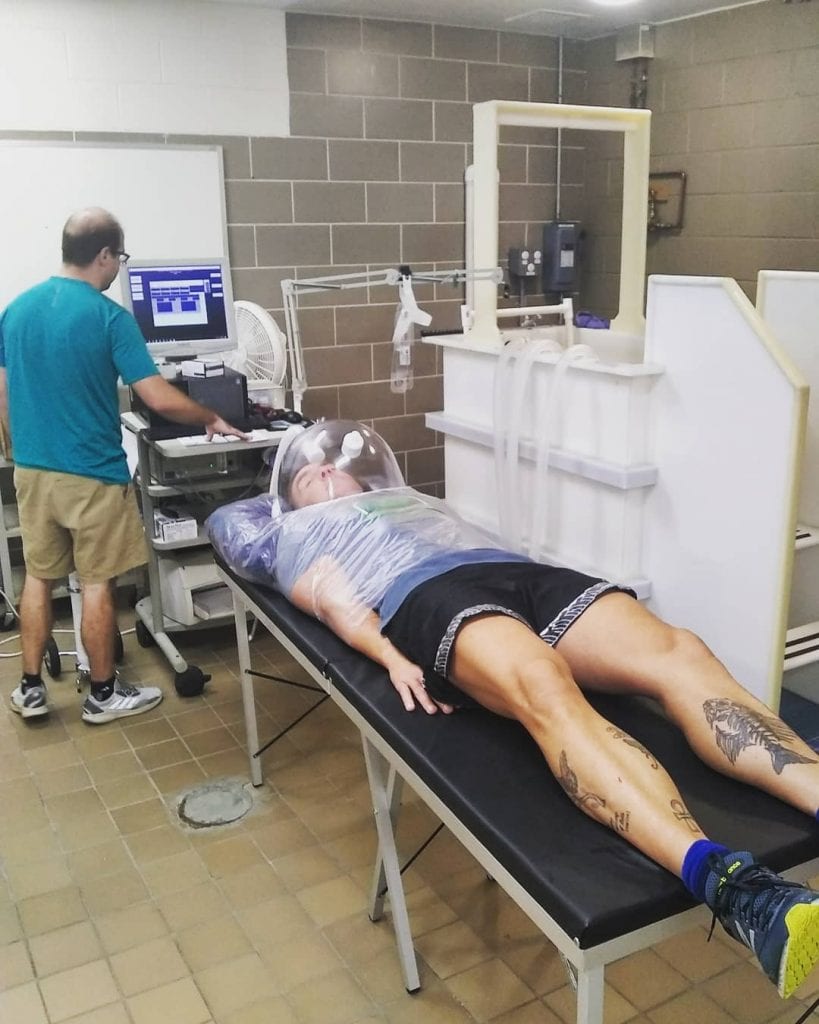
As you will soon understand, it’s virtual impossible for an ultrarunner to replace all of the calories they burn during an ultramarathon. In fact, studies show that energy deficits greater than 1,000 calories a day have been measured in ultrarunners (Costa et al., 2013a; McCubbin et al., 2016).
The good news is that our body stores “fuel” in the form of glycogen in muscles and liver, glucose in the blood, and fat stores that can be converted to fuel. So, just because we cannot replace all of the calories we burn, does not mean we are going to “run out” of fuel, as our body already has a solid backup waiting in storage.
But, having a general idea of your personal hourly caloric expenditure can give you a better idea of where to start when it comes time to figure out how many calories you, personally, should take in per hour.
A Quick Review on Energy Systems
Don’t worry, I promise I’m not going to go down a rabbit hole of explaining energy systems, cellular respiration, lactate threshold, and the like (but if you’re curious to learn more, dive into this post, covering tempo runs and lactate threshold.)
In the simplest of explanations, the food we eat consists of three macronutrients: carbohydrates, fat, and protein. At times, our body uses all three of these macronutrients as fuel sources. However, carbohydrates can be metabolized both aerobically and anaerobically (with or without oxygen, depending on the intensity of exercise) and are metabolized much faster than protein or fat, making carbohydrates a highly efficient fuel source. This is why the majority of engineered endurance fuel sources (gels, chews, drinks, etc.) focus heavily on carbohydrates.
Recommended Carbohydrates per Hour
Now that we’ve talked about expenditure, let’s talk about intake.
For a long time it was believed that the average runner could only absorb about one gram of carbohydrates per minute, or 60g per hour. For reference, there are 4 calories per gram of carbohydrate, therefore meaning that most runners would max out at about 240 calories an hour.
The main reason for this is because while running, blood is diverted to more important systems (such as the brain, heart, lungs, and muscles) and away from less important systems (such as digestion), therefore slowing down digestion.
No matter what your caloric expenditure may be per mile, even at a very conservative pace of 4 miles per hour, it’s easy to see that by only consuming a maximum of 240 calories an hour would mean that a runner can not replace all the calories that they burn, and most would be seriously calorically deficient pretty early on into an ultramarathon.
Fortunately for ultrarunners everywhere, there are scientists constantly pursuing nutrition and fueling research as it pertains to athletes. As such, science has discovered that you can, in fact, train your stomach to handle larger amounts of carbohydrates per hour, especially if you mix up your carbohydrate sources to include both glucose and fructose. Thus, the current recommended carbohydrate intake per hour for ultrarunners has been bumped up to 60 – 90 g/hour, or upwards of 360 calories an hour from carbohydrate sources.
Better yet: more recent studies have found an intake of 120 grams of carbs per hour by mountain runners had lower training stress and less muscle damage during the running events.
But,120 grams is double 60 grams, and for the untrained athlete’s stomach, diving right in to such a huge carbohydrate consumption while running can leave you running for the port-a-potty. So how do you a) determine how many calories and carbohydrates you should have per hour, and b) teach your gut to tolerate such a huge onslaught of carbs?
You’ve got to practice.
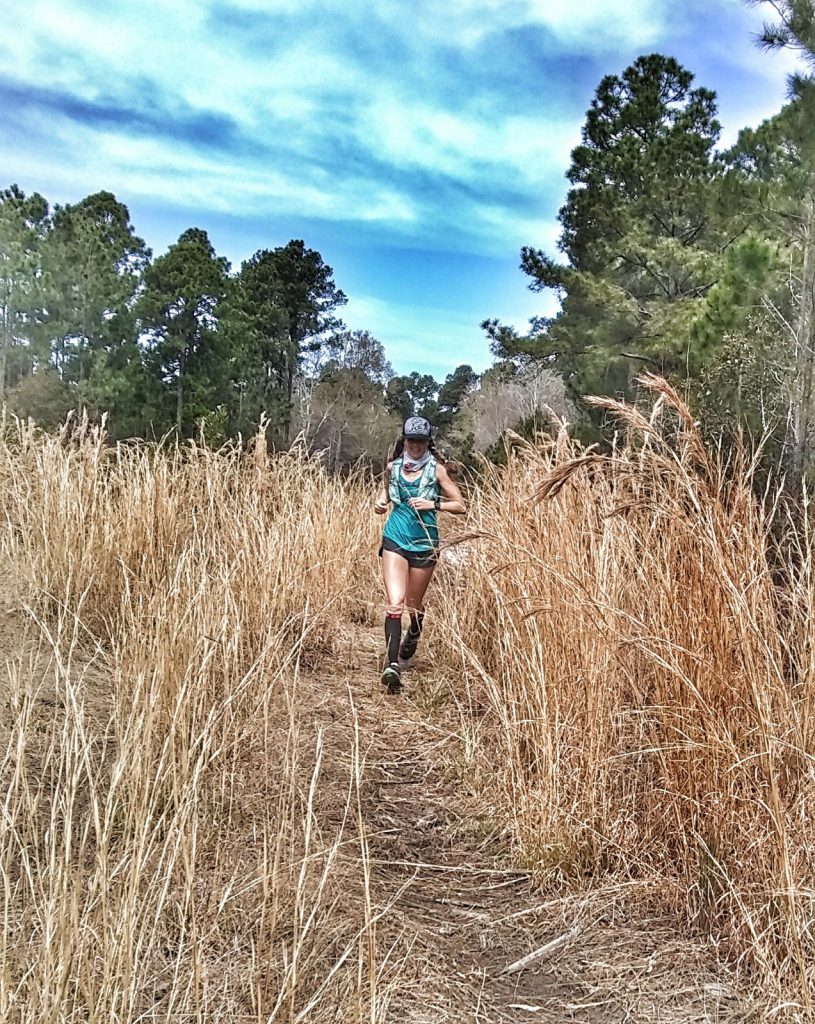
Practicing Fueling for an Ultramarathon During Training
Again, the amount of fuel a runner will need AND can tolerate will vary from person to person. And in order to have your ideal ratio nailed down by race day, you’ve got to practice. Here’s how:
Determine Your Caloric/Carbohydrate Starting Point
My guess is that if you are training for an ultramarathon, fueling during a run is not a new concept for you. As a coach, I typically use the following approach with my athletes as our starting point:
- Start by looking at what has worked for you in the past, or what you enjoy eating during long runs.
- Do the math. How many calories per hour and carbohydrates per hour are you currently taking in during your longer runs or shorter races?
- Determine how far off that number is from the recommended 60-90 g per hour / 240-360 cals per hour. Further, take into consideration how YOUR personal caloric expenditure comes into play. For example, a 110 lb runner is not going to require nearly as much fuel to move their body as a 250 lb runner. If your caloric expenditure is on the higher end, you are going to want to be on the higher end of the recommended range as well.
How to Safely Increase Calories and Carbohydrates:
(And by safely, I simply mean in an attempt to not really anger your digestive system…)
If you have determined you need to bump up your caloric and carbohydrate intake, determine how you are going to start. You can try to either increase your volume per hourly nutrition interval, OR you can shorten the duration between intervals, thus increasing your overall calorie and carbohydrate per hour average.
Remember, there is no hard, fast, rule that says you can or should only eat “once per hour”. Shorter durations of smaller volumes of food work better for some athletes. What matters is that you find something that not only works for you, but that you can easily execute and keep track of. This is where practice makes perfect.
As far as how much to increase your intake? Julie Shobe, a Registered Dietician who specifically works to help ultrarunners fuel their training and racing, suggests the following:
- If you tend to have a sensitive stomach, begin by increasing your hourly carbohydrate intake anywhere from 5-10g per hour. Stay with this increase for at least three separate training runs before attempting another increase.
- If you are a runner who typically doesn’t experience gastrointestinal distress when running, and usually tolerate mid run nutrition well, increasing your carbohydrate intake by 10-15 g per hour is recommended.
Once you’ve determined a starting point, truly pay attention to how you feel. Bonking sooner than you should? Maybe you need more calories per hour. Finding you feel bloated, lethargic, or have an upset stomach? Perhaps you are taking in too much for now; cut back and keep trying.
Race day nutrition is absolutely an experiment of one, and the only way you’ll dial in what works well for you is to practice.
Decide WHAT you are going to eat and HOW.
Are you a fan of liquid nutrition? Or do you prefer to chew your food? Maybe you like a little bit of both. Do you plan to use endurance specific food (gels, drinks, chews, etc.) or will you fuel with “real” food?
There is no shortage of engineered, endurance specific nutrition items on the market geared specifically towards endurance athletes. Further, any visit to an ultramarathon aid station will reveal that it’s more than common to have a buffet full of food waiting for you to consume, such as: pizza, burgers, quesadillas, potato’s, and my favorite: the grilled cheese sandwich.
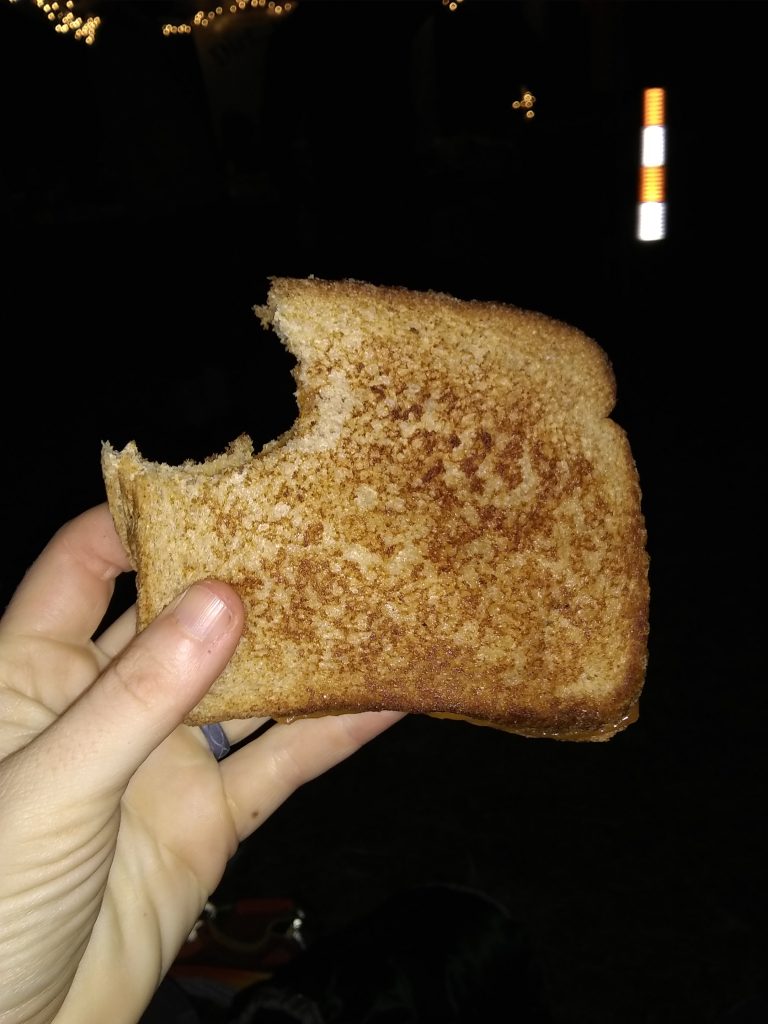
Julie Shobe suggests the following when deciding what types of nutrition sources to consume while racing and training:
“One thing for runners to consider is that consuming high fat foods (like bacon, avocado, pizza, peanut butter, etc.) can increase malabsorption during runs, and cause GI upset and diarrhea. The general recommendation is to avoid high fat foods the day before and morning of a race.
On the flip side, fat offers a more savory flavor which is coveted often for runners late in ultras. So training with high fat foods on long training runs may help runners tolerate these foods while running overtime and with practice. “
Speaking of an GI distress, Shobe also warns that consuming too many high sugar, heavy carbohydrate fuels at one time can also be a recipe for disaster.
“A common mistake is taking a gel and drinking a carb containing fluid (like many sports or electrolyte beverages) to wash it down. Instead, wash down high sugar energy food (like gels, chews, bloks, candy at aid stations, cookies and so on) with water. Drink electrolyte, carb containing beverages between fueling or with foods that have some protein like sandwiches, cheese, pizza, quesadillas…”
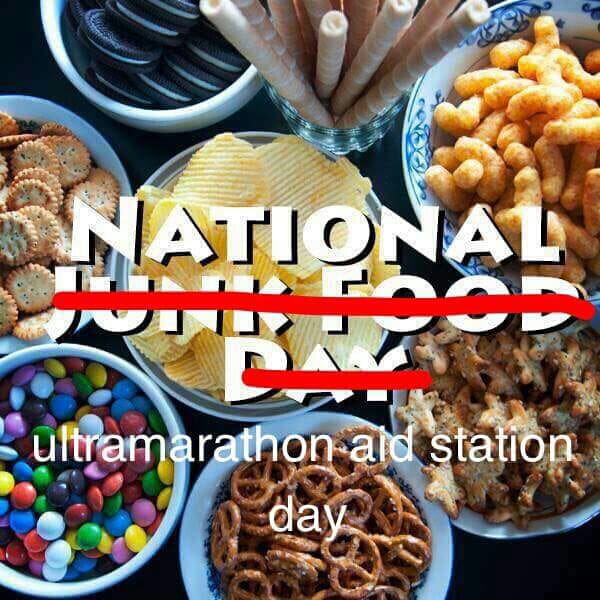
The best time to experiment with nutrition is during training. Keep in mind, just because you like a specific food, doesn’t mean it’s going to work well for you while running, especially due to the aforementioned slowing down of digestion. So practice eating (or drinking) your calories of choice during your training runs, to make sure they work well for you and agree with your stomach.
Start Fueling Early
Do not wait until you start to feel hungry or feel your energy levels waning before you begin fueling.
According to Shobe: “When a runner waits to fuel it gives the stomach an opportunity to ‘fall asleep’ because the blood flow is redirected to working muscles. When the runner does start to fuel the stomach and digestive tract isn’t ready for the food. This can cause nausea, vomiting, lack of appetite, cramping, bloating.
On her Instagram account “Ultra.Runner.Nutrition“, Shobe frequently recommends that your first fueling interval begins within 30 minutes of the onset of your training run. While anecdotal evidence, I have personally began taking a gel at the very start of my run (as in, almost as soon as my sneakers hit the ground) and have found this to be successful for me.
Create a Fail Proof Routine
In the beginning of an ultramarathon, keeping track of your caloric intake is easy. But as the hours and miles fly by, this becomes a more and more difficult task. If you lose track, and start to bonk from the lack of calories, it becomes near impossible. Next thing you know, you can’t remember the last time you ate, but it doesn’t matter because you hate the thought of eating anyway, and then you’re crying over something as silly as the fact that your shoe lace came untied.
You’ve bonked.
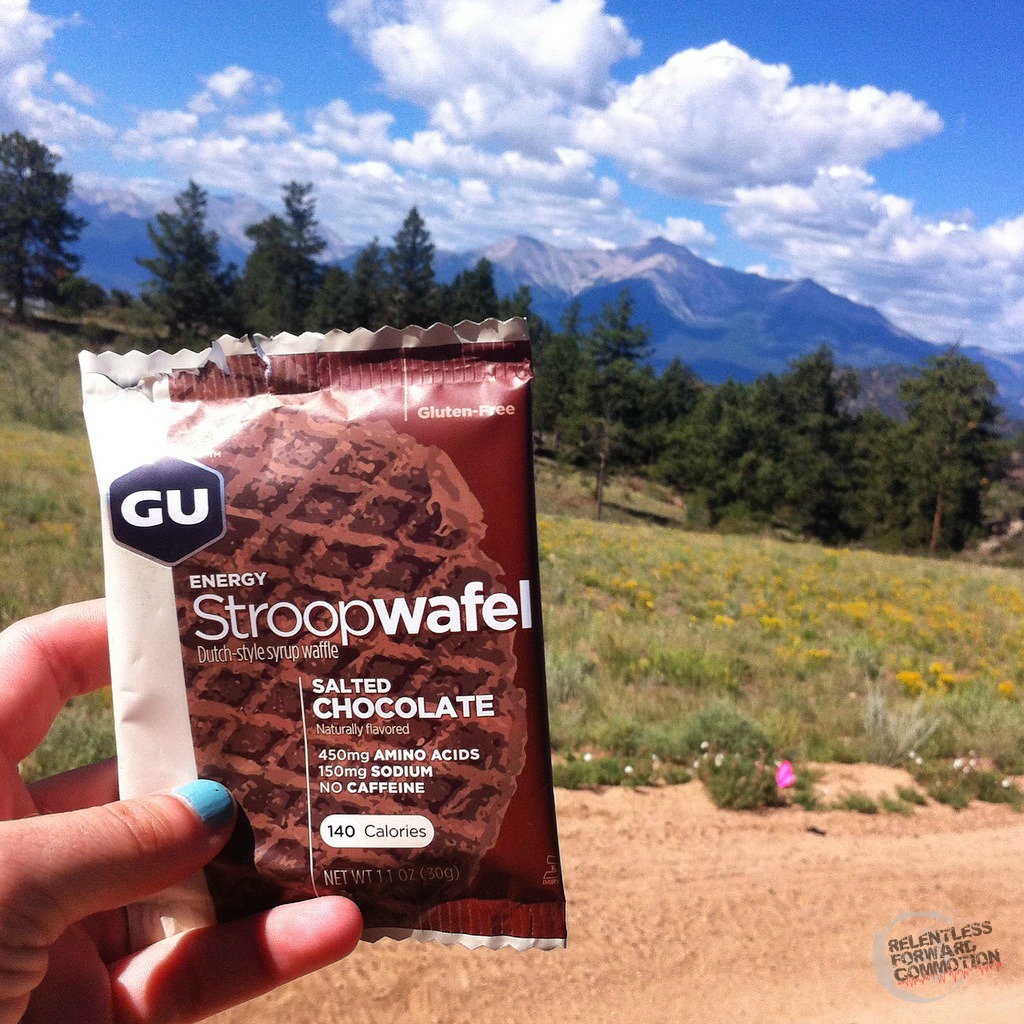
The best way to prevent this is to be proactive with your nutrition. So find a creative way to not only keep track of your calories, but to ensure you take them in. Set an alarm on your watch. Share your plan with a friend or pacer to help ensure you stay on track. Having a tried and true, well practiced routine will ensure you are getting in the calories you need for a successful ultramarathon finish.
Ultramarathon Race Day Nutrition and Fueling Strategy:
You’ve practiced your nutrition game plan. You’ve truly dialed in what works for you. Now here’s how to ensure the plan continues to work throughout the miles and hours of your ultra.
Start fueling from the get go.
As mentioned above, there is absolutely no way to take in as many calories as you burn over an ultramarathon. Your best bet in beating a massive caloric deficiency is to ensure that you begin fueling from the start of the race, NOT a few hours later when you find yourself hungry.

Keep track of your nutrition.
Do. Not. Wing it. How do I know? Because I’ve bonked, more times than I can count, trying to “guess” if I’ve eaten enough (the answer was always no, I hadn’t eaten enough).
This is where a crew comes in mighty handy. They know before hand how many calories you need, and they can make sure you get them. No unnecessary energy wasted on counting calories for you.
Have a backup plan (and a backup-backup-plan)
Inevitably, there will come a point in your race where you suddenly can no longer stand your fuel of choice. There may come a point when the Tailwind you’ve been drinking for the last 12 hours is now a vile, horrible concoction that you no longer want anything to do with. Or the thought of taking in another gel makes your stomach turn.
This is the point where so many ultrarunners go wrong: they simply stop eating. The palate fatigue is too much for their already exhausted mental state to handle, so they just stop eating.
And from experience, I assure you…this is where everything begins to fall apart. Trust me when I tell you that the worst thing you can do is stop fueling your body. Find an alternative, slow down or lower your caloric intake, but whatever you do, don’t stop all together, or you’ll be on the one way train to Bonk City.
Have a backup nutrition plan for when (likely not “if”, but “when”) this happens.
Final Thoughts:
Fueling for an ultramarathon can seem like an endurance event in itself. Over time, however, you will narrow down what works for you as far as nutrition, if you keep practicing. Don’t wait for race day and gorge on the pizza and skittles at the aid station…unless, of course, that was part of your plan.
Huge thanks to Julie Shobe, MS RDN, C-PT, for her help with this post. If you are interested in one on one coaching to help overcome your mid-race or training fueling issues, or are interested in learning how to fuel for before, during and after running ultras, you can contact Julie via her Instagram page: @ultra.runner.nutrition
Heather Hart is an ACSM certified Exercise Physiologist, NSCA Certified Strength and Conditioning Specialist (CSCS), UESCA certified Ultrarunning Coach, RRCA certified Running Coach, co-founder of Hart Strength and Endurance Coaching, and creator of this site, Relentless Forward Commotion. She is a mom of two teen boys, and has been running and racing distances of 5K to 100+ miles for over a decade. Heather has been writing and encouraging others to find a love for fitness and movement since 2009.


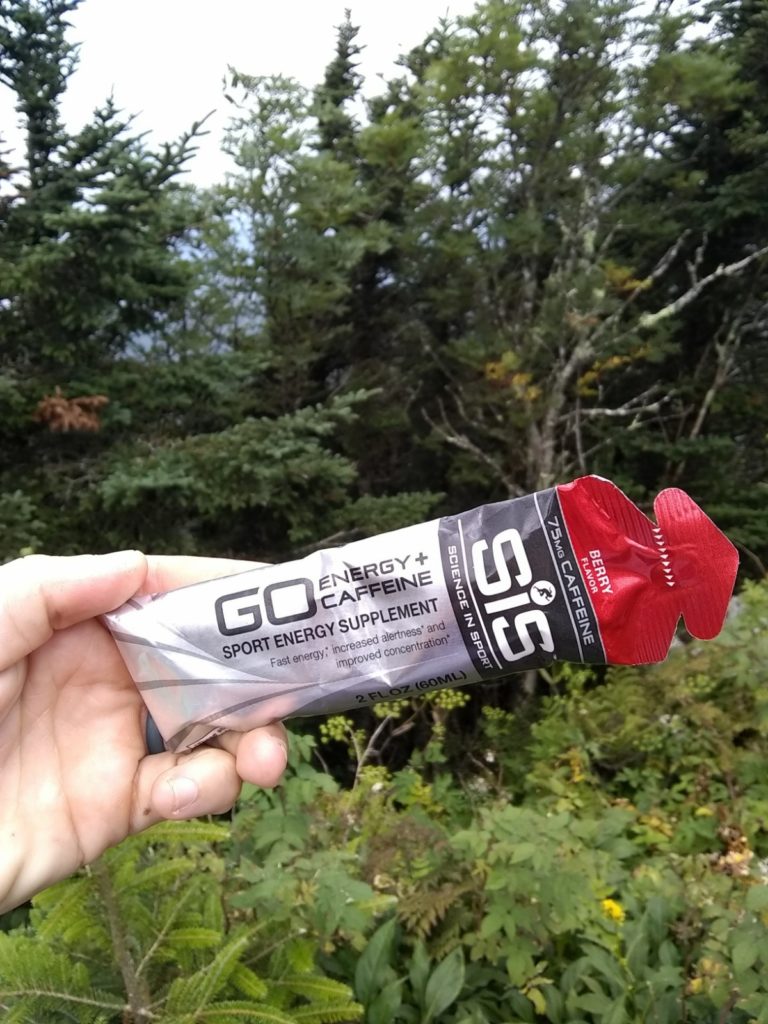
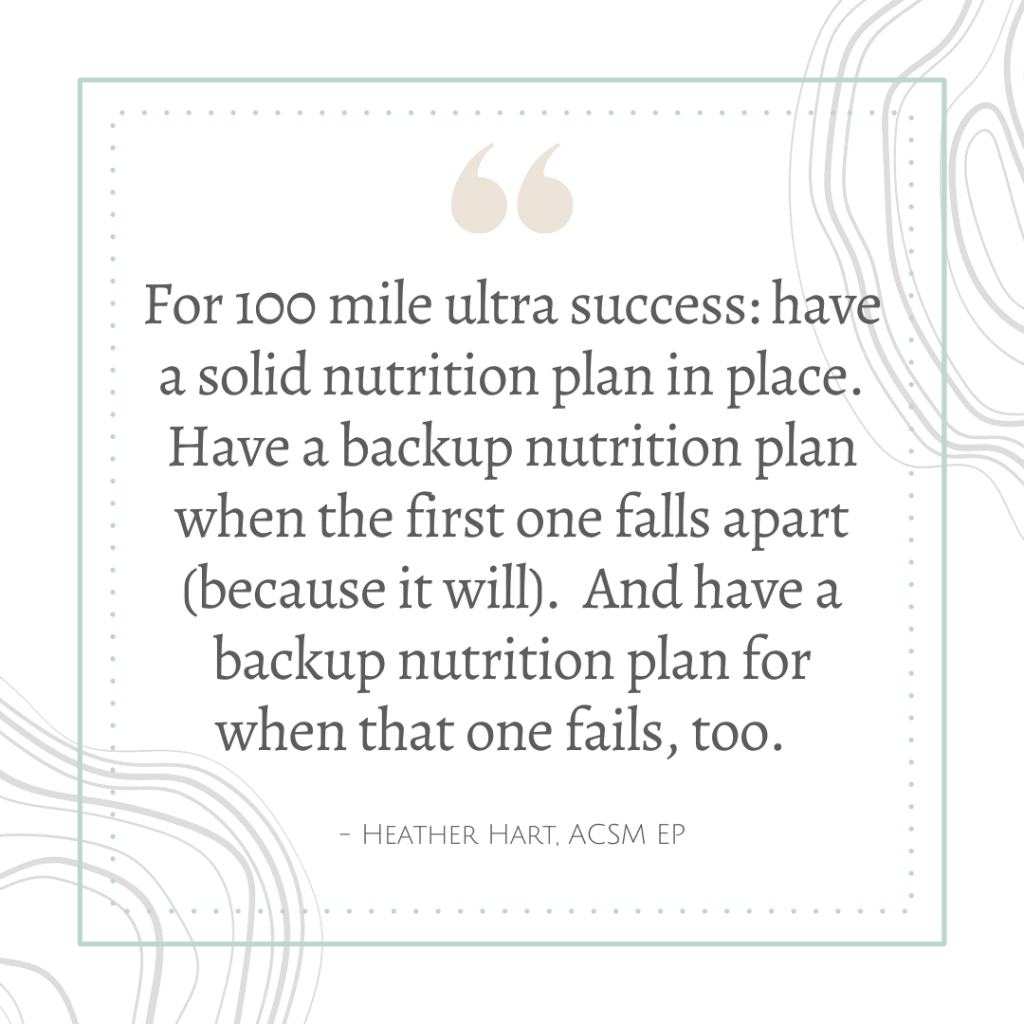
hannah
Thanks Heather! This was a really informative post and having all the various things I know to be true summarized in one place is so useful. I especially like your tips and tricks. As much as it is definitely experiment of one (you are so right there), it’s really helpful to hear what worked for other people in terms of inspiration.
Personally I’ve found coke to my own manna of the gods I bought terms of turning around any kind of funk or crappy feelings.
Heather
YESSSSS coke is the best during a race ! I really don’t like it any other time, but halfway through a tough race, it’s incredible!
Joseph Diehl
Great tips. When I consume Gu or similar products during the race, my digestive system reacts negatively and sometimes, my body expels it (vomiting). Now, I carry along some pre-cooked burritos, beans/rice in a baggie and Boost electrolyte drink with caffeine. I think I am dialing it in and this was confirmed by your article. I am 74 years old and I stand out in most ultramarathons as one of the folks known as, “the last man standing” or maybe – the last man slowly running!